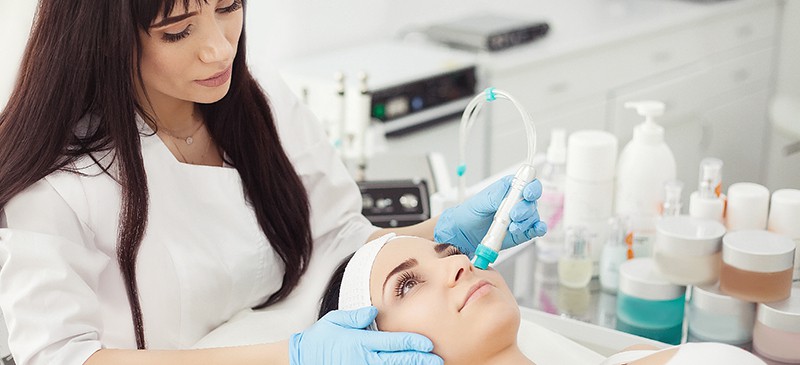
It’s so easy to create your own homemade face mask using natural ingredients. Homemade skin treatments don’t take a lot of time or money, and the results be impressive — but have you ever had someone else (an esthetician) give you a facial?
Not only can it be extremely relaxing, but it can often take benefits to the next level.
If you’ve ever received a professional facial then may already be familiar with estheticians. Let’s take a closer look at this profession (you can work for yourself or someone else) and the potential benefits of seeing an esthetician.
What Is an Esthetician?
An esthetician is someone who is professionally trained to perform skincare treatments, such as facials and more, and estheticians are experts when it comes to aesthetics.
What is aesthetics? Aesthetics (also spelled esthetics) is a branch of cosmetology.
Cosmetology is defined as the work of improving the appearance of a customer’s face, hair or skin using makeup and beauty treatments.
Estheticians work in spas, salons and medical offices. Also known as aestheticians, they are skincare specialists.
Depending on the state he or she lives in, an esthetician has received a specific amount of esthetics training to be certified to perform various skin treatments, such as facials, microdermabrasion, chemical peels, hair removal and more.
In addition to performing skin treatments, an esthetician job description often includes providing facial and neck massages and conducting facial hair removal. You can find estheticians that specialize in holistic or natural skin care too.
Estheticians are not medical doctors. They cannot take the place of dermatologists, who are medically trained experts that treat diseases of the skin, hair, and nails.
If you have a skin concern such as a dermatitis or a suspicious mole, you want to see a dermatologist, not an esthetician.
Throughout their training, estheticians learn how to care for and improve the health and appearance of the skin through non-invasive treatments. If you’re looking to improve the appearance of your skin, they can help evaluate the current condition of your skin as well as your cosmetic concerns and skincare goals.
Types/Varieties
Where are you likely to find an esthetician working? You’ll find most working in spas, including day spas and medi-spas, as well as salons.
You may also find one working with a dermatologist or cosmetic surgeon. This person may be referred to as a medical esthetician, which can be confusing because this terminology tends to make clients think that the esthetician has specialized medical training.
Most often, a medical esthetician is someone performing esthetics in a clinical or medical setting under the supervision of a licensed health care professional. For example, a medical esthetician may work under the supervision of a medical professional like a dermatologist who recommends non-invasive skincare procedures and/or treatments to improve the health and appearance of the skin.
READ RELATED: 12 SPF Products That You’ll Actually Enjoy Wearing
Health Benefits/Uses
What does an esthetician do? Types of services and potential benefits of seeing an esthetician include:
- Skin evaluation (including skin type)
- Pore extractions
- Chemical peels
- Acne/breakout reduction
- Anti-aging effects, including reduction of the appearance of fine lines and age spots
- Decreased hyperpigmentation
- Improved moisture levels
- Microdermabrasion
- Body masks, wraps and scrubs
- Face/body waxing
If you visit an esthetics medi-spa, you’ll likely see Botox as an available treatment. Can an esthetician do botox?
According to the website Estheticianedu.org:
Estheticians are not allowed to administer Botox injections, although they can assist the doctor, nurse, or physician assistant by providing pre- and post-procedure care. To be clear, this is considered a cosmetic procedure and can only be performed by a licensed medical professional.
Training and Certification
To receive certification as an esthetician, you need to receive technical education and training from an accredited esthetician program.
How long does it take to be an esthetician?
To become one, you need to have a license issued to your by your state. The requirements for licensing vary depending upon the state.
Typically, most states’ esthetician programs require that you complete at least 600 hours of training. After you complete your course, you then need to take and successfully pass a State Esthetics License Examination.
To see what your state requires, you can visit Estheticianedu.org.
A high-quality program can range in cost from $3,000 to $10,000. The price can vary based on a state’s required training hours, the length of the program and location.
Is an esthetician a good career? The median annual esthetician salary as of 2018 was $31,290.
According to the U.S. Bureau of Labor Statistics, esthetician jobs are predicted to grow by 11 percent between 2018 and 2028, which is a lot faster than the average growth rate for all occupations.
Risks and Side Effects
The risks and side effects of seeing an esthetician can vary depending upon the treatment and products used. Some estheticians use natural beauty products, while others may use products with questionable ingredients and strong chemicals.
Don’t be afraid to ask questions and research the possible risks and side effects of a treatment or product offered by an esthetician.
Conclusion
- The esthetician definition is a professional skincare specialist who is trained to assess and improve the skin through the use of various treatments and services.
- Estheticians can help improve the appearance of the skin by reducing acne, decreasing redness, increasing moisture, reducing the appearance of fine lines and wrinkles, removing unwanted hair, and more.
- How to become an esthetician depends upon your state’s requirements for receiving an esthetician license.
- Jobs in this field are the rise for the foreseeable future, and you can work in a variety of settings, including spas, salons and doctors’ offices.
- Look for estheticians that use natural beauty products to avoid unhealthy ingredients.
Source: Dr. Axe






